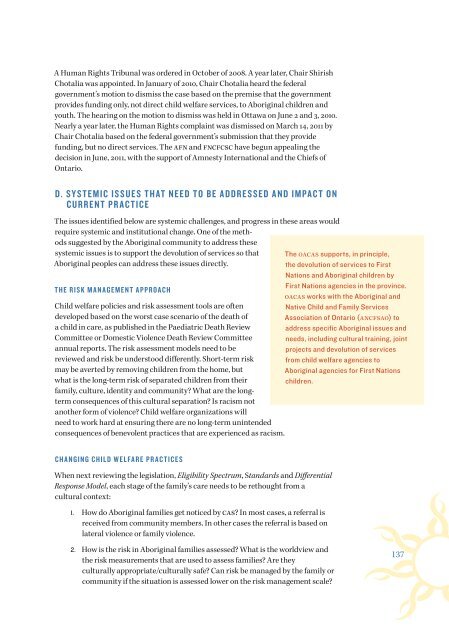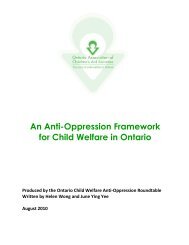English - Ontario Association of Children's Aid Societies
English - Ontario Association of Children's Aid Societies
English - Ontario Association of Children's Aid Societies
You also want an ePaper? Increase the reach of your titles
YUMPU automatically turns print PDFs into web optimized ePapers that Google loves.
A Human Rights Tribunal was ordered in October <strong>of</strong> 2008. A year later, Chair Shirish<br />
Chotalia was appointed. In January <strong>of</strong> 2010, Chair Chotalia heard the federal<br />
government’s motion to dismiss the case based on the premise that the government<br />
provides funding only, not direct child welfare services, to Aboriginal children and<br />
youth. The hearing on the motion to dismiss was held in Ottawa on June 2 and 3, 2010.<br />
Nearly a year later, the Human Rights complaint was dismissed on March 14, 2011 by<br />
Chair Chotalia based on the federal government’s submission that they provide<br />
funding, but no direct services. The AFN and FNCFCSC have begun appealing the<br />
decision in June, 2011, with the support <strong>of</strong> Amnesty International and the Chiefs <strong>of</strong><br />
<strong>Ontario</strong>.<br />
D. SYSTEMIC ISSUES THAT NEED TO BE ADDRESSED AND IMPACT ON<br />
CURRENT PRACTICE<br />
The issues identified below are systemic challenges, and progress in these areas would<br />
require systemic and institutional change. One <strong>of</strong> the methods<br />
suggested by the Aboriginal community to address these<br />
systemic issues is to support the devolution <strong>of</strong> services so that<br />
Aboriginal peoples can address these issues directly.<br />
THE RISK MANAGEMENT APPROACH<br />
Child welfare policies and risk assessment tools are <strong>of</strong>ten<br />
developed based on the worst case scenario <strong>of</strong> the death <strong>of</strong><br />
a child in care, as published in the Paediatric Death Review<br />
Committee or Domestic Violence Death Review Committee<br />
annual reports. The risk assessment models need to be<br />
reviewed and risk be understood differently. Short-term risk<br />
may be averted by removing children from the home, but<br />
what is the long-term risk <strong>of</strong> separated children from their<br />
family, culture, identity and community What are the longterm<br />
consequences <strong>of</strong> this cultural separation Is racism not<br />
another form <strong>of</strong> violence Child welfare organizations will<br />
need to work hard at ensuring there are no long-term unintended<br />
consequences <strong>of</strong> benevolent practices that are experienced as racism.<br />
The OACAS supports, in principle,<br />
the devolution <strong>of</strong> services to First<br />
Nations and Aboriginal children by<br />
First Nations agencies in the province.<br />
OACAS works with the Aboriginal and<br />
Native Child and Family Services<br />
<strong>Association</strong> <strong>of</strong> <strong>Ontario</strong> (ANCFSAO) to<br />
address specific Aboriginal issues and<br />
needs, including cultural training, joint<br />
projects and devolution <strong>of</strong> services<br />
from child welfare agencies to<br />
Aboriginal agencies for First Nations<br />
children.<br />
CHANGING CHILD WELFARE PRACTICES<br />
When next reviewing the legislation, Eligibility Spectrum, Standards and Differential<br />
Response Model, each stage <strong>of</strong> the family’s care needs to be rethought from a<br />
cultural context:<br />
1. How do Aboriginal families get noticed by CAS In most cases, a referral is<br />
received from community members. In other cases the referral is based on<br />
lateral violence or family violence.<br />
2. How is the risk in Aboriginal families assessed What is the worldview and<br />
the risk measurements that are used to assess families Are they<br />
culturally appropriate/culturally safe Can risk be managed by the family or<br />
community if the situation is assessed lower on the risk management scale<br />
137

















